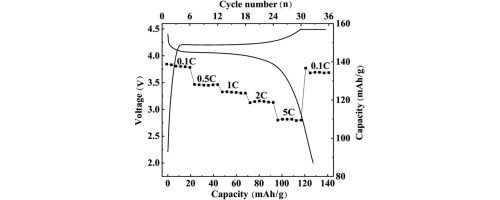Particuology ( IF 3.5 ) Pub Date : 2017-03-28 , DOI: 10.1016/j.partic.2016.10.006 Yunfei Long , Zhihua Zhang , Zhi Wu , Jing Su , Xiaoyan Lv , Yanxuan Wen

|
We synthesized LiMnPO4/C with an ordered olivine structure by using a microwave-assisted polyol process in 2:15 (v/v) water–diethylene glycol mixed solvents at 130 °C for 30 min. We also studied how three surfactants—hexadecyltrimethylammonium bromide, polyvinylpyrrolidone k30 (PVPk30), and polyvinylpyrrolidone k90 (PVPk90)—affected the structure, morphology, and performance of the prepared samples, characterizing them by using X-ray diffraction, scanning electron microscopy, transmission electron microscopy, charge/discharge tests, and electrochemical impedance spectroscopy. All the samples prepared with or without surfactant had orthorhombic structures with the Pnmb space group. Surfactant molecules may have acted as crystal-face inhibitors to adjust the oriented growth, morphology, and particle size of LiMnPO4. The microwave effects could accelerate the reaction and nucleation rates of LiMnPO4 at a lower reaction temperature. The LiMnPO4/C sample prepared with PVPk30 exhibited a flaky structure coated with a carbon layer (∼2 nm thick), and it delivered a discharge capacity of 126 mAh/g with a capacity retention ratio of ∼99.9% after 50 cycles at 1C. Even at 5C, this sample still had a high discharge capacity of 110 mAh/g, demonstrating good rate performance and cycle performance. The improved performance of LiMnPO4 likely came from its nanoflake structure and the thin carbon layer coating its LiMnPO4 particles. Compared with the conventional polyol method, the microwave-assisted polyol method had a much lower reaction time.
中文翻译:

微波辅助合成LiMnPO 4 / C的多元醇及其在锂离子电池正极材料中的应用
我们使用微波辅助多元醇工艺,在130°C下以2:15(v / v)的水-二甘醇混合溶剂合成了有序橄榄石结构的LiMnPO 4 / C。我们还研究了十六烷基三甲基溴化铵,聚乙烯吡咯烷酮k30(PVPk30)和聚乙烯吡咯烷酮k90(PVPk90)这三种表面活性剂如何影响所制备样品的结构,形态和性能,并通过X射线衍射,扫描电子显微镜,透射电镜对其进行了表征。电子显微镜,充电/放电测试和电化学阻抗谱。所有有或没有表面活性剂制备的样品均具有Pnmb的正交结构空间群。表面活性剂分子可能已经充当了晶面抑制剂,以调节LiMnPO 4的定向生长,形态和粒径。微波效应可以在较低的反应温度下加速LiMnPO 4的反应和成核速率。用PVPk30制备的LiMnPO 4 / C样品呈现出薄片状结构,表面覆盖有碳层(约2 nm厚),在1C下经过50次循环后,其放电容量为126 mAh / g,容量保持率约为99.9%。 。即使在5℃下,该样品仍具有110mAh / g的高放电容量,证明了良好的速率性能和循环性能。LiMnPO 4的改进性能可能来自其纳米片状结构和覆盖LiMnPO 4颗粒的薄碳层。与常规多元醇方法相比,微波辅助多元醇方法的反应时间短得多。


























 京公网安备 11010802027423号
京公网安备 11010802027423号